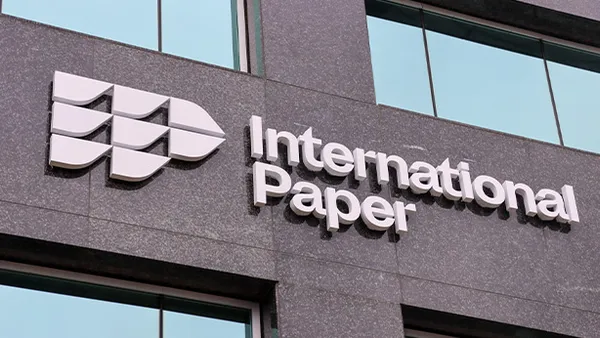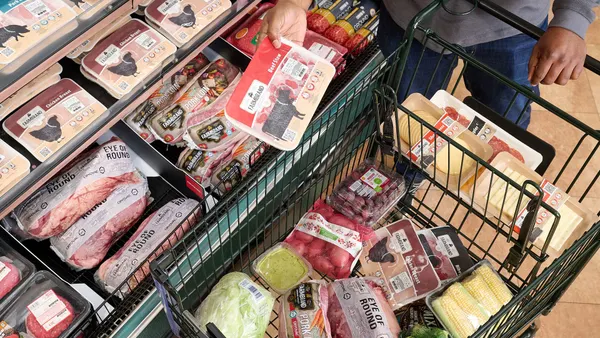Dive Brief:
- Bloomberg Index Services Ltd. is accepting customers for its recently launched commodity pricing index for corrugated boxes. The Bloomberg Corrugated Box Cost Index is designed to be a transparent tool for both box buyers and sellers.
- This index relies on an algorithm that considers eight inputs used in manufacturing and shipping boxes, including OCC costs, hourly wages and maintenance rates. Half of those inputs also have their own futures markets, said Ryan Fox, corrugated packaging market analyst at Bloomberg Intelligence, during a webinar Tuesday. “You can therefore use this as a calculator, of sorts, and create future scenarios.”
- This model serves as an alternative to existing fiber pricing indexes, such as a widely used 42-pound kraft linerboard index. “Bloomberg is presenting this as a neutral third party,” said Doug Larsen, corrugated market analyst at Green Markets, a Bloomberg company. “This concept provides a more holistic cost representation.”
Dive Insight:
Fiber manufacturing and sales have changed over the last several decades, Bloomberg representatives said during the webinar, but most pricing indexes haven’t kept up with the transformations. This new box pricing index accounts for such changes, they said.
Historically, many contracts in the fiber industry were tied to the price of 42-pound linerboard — weighing 42 pounds per 1,000 square feet — “but today, 42-pound is a very minor part of what’s used,” Larsen said. In addition, previous contracts were tied to pricing guidance from various trade publications. Those are among the many elements that have changed since the 1970s and 1980s, he said, also pointing to evolving methodologies for calculating box price movement.
Another change is that industry consolidation has altered individual companies’ market shares and business strategies. Now, “the industry as we know it is roughly 90% vertically integrated,” Fox said. Vertically integrated producers transfer paper materials manufactured at their own mills to their own converting facilities. Only about 5% to 10% of containerboard produced in the modern era heads into the open market, speakers said, and that proportion continues to shrink.
However, commonly used fiber pricing indexes, such as Fastmarkets RISI’s, still are linked to the open market. “It's a dilemma today in that if you're only considering open market, you’re not considering 90% of the market,” Larsen said, adding that it “doesn’t seem like the right thing to do.”
The pricing index debate gained steam in 2024 when all the major producers announced price increases for linerboard and other grades to start the year, but the monthly pricing in Fastmarkets RISI’s weekly report, Pulp and Paper Week, showed no price movement in January and only partial recognition of the increases in February. Producers then launched another round of increases during the summer to make up for it. A similar scenario played out earlier this year, when the index only reflected a partial price increase following price hikes announced to take effect Jan. 1.
Executives at numerous fiber producers, including International Paper and Packaging Corporation of America, have expressed discontent with leading pricing index methodologies. Several have indicated they would abandon third-party pricing indexes altogether.
Graphic Packaging International was the first to announce it would make the move, when executives disclosed in October that the company would shift away from these indexes in early 2025. They reported good progress on the transition in February, and as of this month’s earnings call, “We have our new index model, which will inflect positive on pricing,” said CFO Stephen Scherger.
“What we're hearing from both producers and buyers is something needs to change. And we're offering an alternative,” Green Markets’ Larsen said.
Another industry transformation is that “the percentage of boxes that are actually sold on contract has gone up dramatically,” he noted. Fox agreed, saying he was shocked to hear on PCA’s recent earnings call that 70% of the company’s box sales were tied to a contract.
Contracts often contain “triggers” that are linked to commonly used indexes. Bloomberg isn’t suggesting its index should be used for such purposes, but rather it intends to present data in a way that could change pre-existing ideas about box pricing in supply contracts.
“How buyers and sellers use this is up to them,” Larsen said. “We’re not trying to tell people how to use it. We're trying to say this is the data, and you can choose to review your prices monthly or quarterly or semi-annually or whatever fits your business model.”
Bloomberg Index Services is developing other fiber indexes, too. A tool for folding cartons is expected to be released publicly in the next few weeks.










